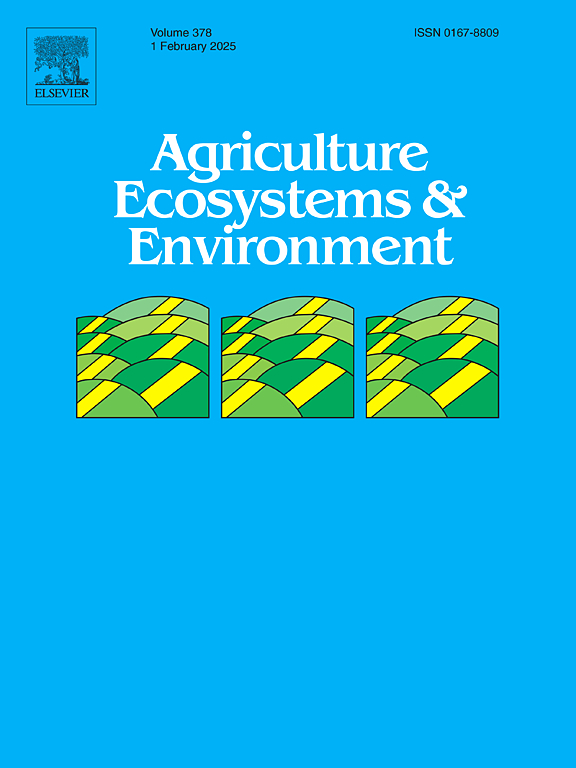Light grazing reduces temporal variation in soil organic carbon in an alpine peatland: Perspectives from fungal communities
IF 6
1区 农林科学
Q1 AGRICULTURE, MULTIDISCIPLINARY
引用次数: 0
Abstract
Waterlogged alpine peatlands harbour substantial reserves of recalcitrant soil organic carbon (SOC) that is mainly decomposed by soil fungi. Even a slight fluctuation in peatland SOC can considerably alter C emissions, thereby impacting the future trajectory of climate change. These peatlands are often subject to yak grazing, which can affect ecosystem functions. However, how grazing regulates microbially mediated temporal variations in SOC in alpine peatlands remains largely unclear. Therefore, we conducted a field experiment on the Zoige Plateau to explore the effects of grazing on peatland soil C content and its association with soil fungal communities during different seasons (spring, summer, and autumn). Grazing significantly increased SOC in spring but not in the subsequent seasons. Furthermore, grazing significantly increased soil water contents in summer, dissolved organic carbon contents in autumn, and N-acetyl-β-D-glucosaminidase and leucine aminopeptidase activities in spring and autumn, but decreased phenol oxidase activity in spring and summer. Grazing significantly reduced fungal diversity at α and β scales. The coefficient of variation of SOC was significantly reduced by grazing, whereas similar trends were not observed for dissolved organic carbon or for dissolved organic and inorganic nitrogen. In the fenced area, the coefficient of variation of fungal species richness was the most important factor for predicting that of SOC. In the grazed area, coefficient of variation of soil NH4+-N contributed the most to that of SOC. These findings underscore the pivotal role of fungal community in affecting SOC dynamics in alpine peatlands, which is crucial for understanding the ecological processes that maintain soil C cycling in alpine ecosystems.
轻放牧减少了高寒泥炭地土壤有机碳的时间变化:来自真菌群落的观点
浸水的高寒泥炭地蕴藏着大量的顽固性土壤有机碳(SOC),主要由土壤真菌分解。即使泥炭地有机碳的微小波动也能显著改变碳排放,从而影响未来气候变化的轨迹。这些泥炭地经常放牧牦牛,这可能会影响生态系统功能。然而,放牧如何调节微生物介导的高山泥炭地有机碳的时间变化仍不清楚。为此,本研究在若尔盖高原开展了不同季节(春、夏、秋)放牧对泥炭地土壤C含量的影响及其与土壤真菌群落的关系。放牧在春季显著增加了土壤有机碳,但在随后的季节中没有显著增加。此外,放牧显著提高了夏季土壤含水量和秋季土壤溶解有机碳含量,显著提高了春季和秋季土壤n -乙酰-β- d -氨基葡萄糖苷酶和亮氨酸氨基肽酶活性,显著降低了春季和夏季土壤酚氧化酶活性。放牧显著降低了α和β尺度真菌多样性。放牧显著降低了土壤有机碳的变异系数,而溶解有机碳和溶解有机无机氮的变异系数没有出现类似的变化趋势。在围栏区域,真菌物种丰富度变异系数是预测土壤有机碳最重要的因子。放牧区土壤NH4+-N变异系数对土壤有机碳变异系数贡献最大。这些发现强调了真菌群落在影响高寒泥炭地有机碳动态中的关键作用,这对于理解高寒生态系统中维持土壤C循环的生态过程至关重要。
本文章由计算机程序翻译,如有差异,请以英文原文为准。
求助全文
约1分钟内获得全文
求助全文
来源期刊

Agriculture, Ecosystems & Environment
环境科学-环境科学
CiteScore
11.70
自引率
9.10%
发文量
392
审稿时长
26 days
期刊介绍:
Agriculture, Ecosystems and Environment publishes scientific articles dealing with the interface between agroecosystems and the natural environment, specifically how agriculture influences the environment and how changes in that environment impact agroecosystems. Preference is given to papers from experimental and observational research at the field, system or landscape level, from studies that enhance our understanding of processes using data-based biophysical modelling, and papers that bridge scientific disciplines and integrate knowledge. All papers should be placed in an international or wide comparative context.
 求助内容:
求助内容: 应助结果提醒方式:
应助结果提醒方式:


